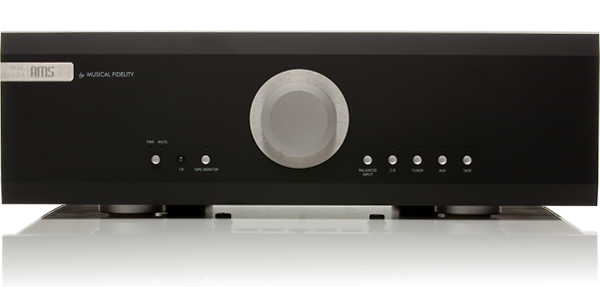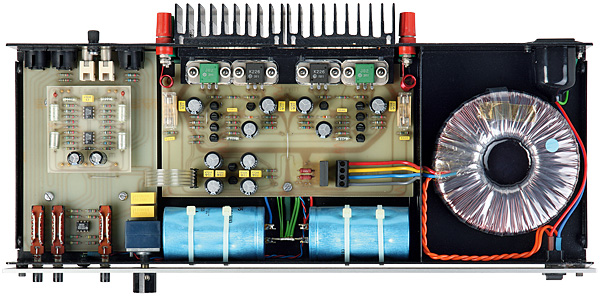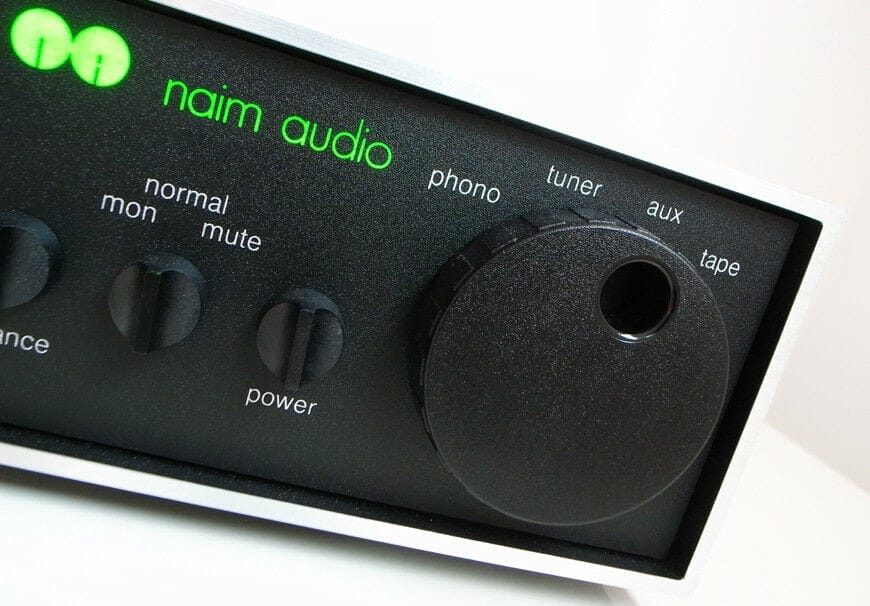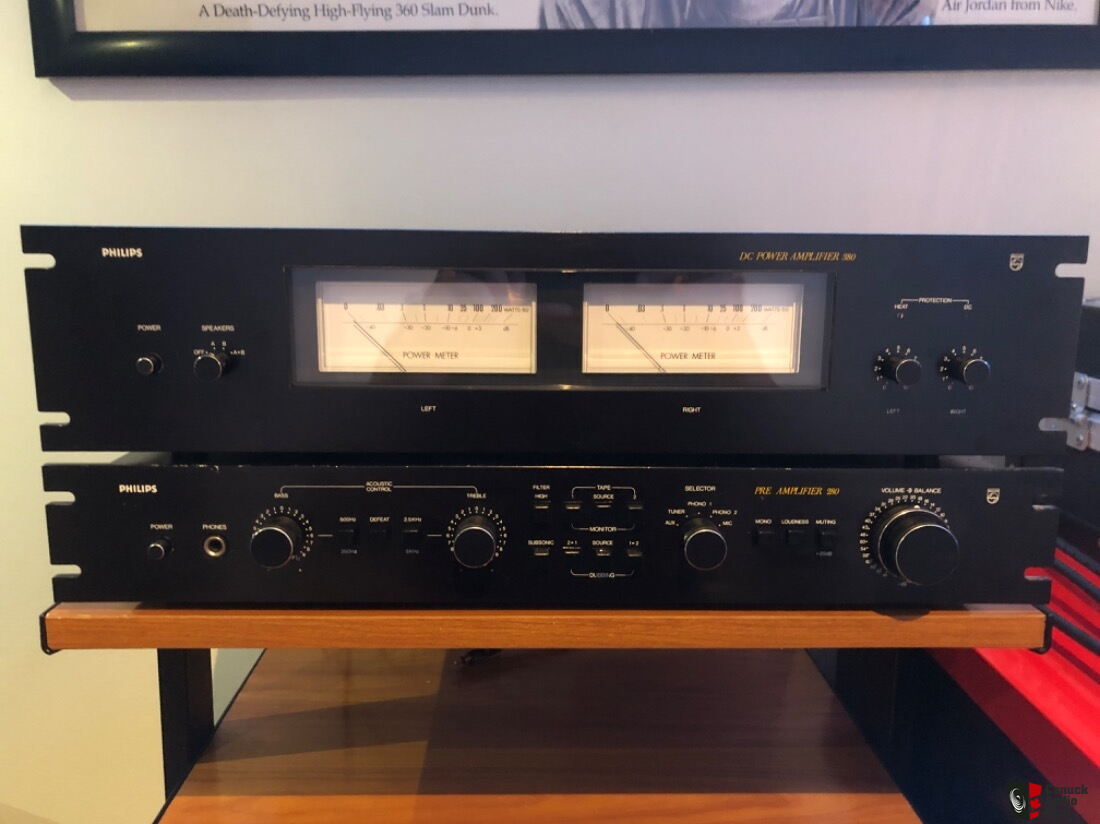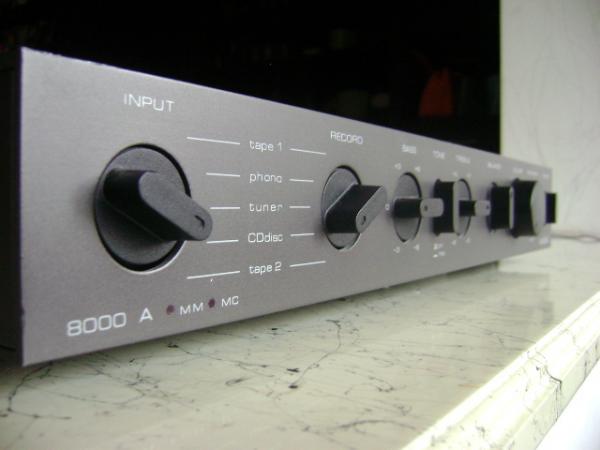When you talk to Antony Michaelson about his vast product portfolio, there are a few designs in particular that he adores, one of which is the A1000. It’s a two-box design, with the first housing the amplifier and the second housing the power supply (11kg and 7kg respectively). Two sets of eight substantially heatsinked transistors, inhaled by two bulky toroidal transformers in the other box, produced 50W RMS in pure Class A. Switch it on, and despite all that sophisticated heatsinking, most of the casework was too hot to handle within an hour, thanks to its massive power consumption!
Antony declared the AMS35i to be the A1000’s spiritual successor when he handed it on to me, and it’s easy to see why. It’s all Class A into an 8 Ohm load. Many manufacturers claim their goods are ‘pure Class A’ amplifiers, but they are actually Class AB amps skewed somewhat more towards Class A, he claims. He claims that this is not the case with the ’35i, citing the temperature rise of the enormous heatsinks (about 35oC) as proof. To put it bluntly, after an hour of listening to my review sample, the central heating ran out, and I considered preparing myself some cheese on toast right there in my listening room…
The AMS35i is a dual mono amplifier with 35W RMS per channel into 8 ohms, each ‘bank’ with its own independent transformer. Separate power supply and transformer windings are also used in the preamp. “A direct descendant of the Titan and AMS50 circuit designs and is very closely connected to them,” according to the circuitry.
This is one of the most appealing modern Musical Fidelity devices I’ve seen in a long time, looking purposeful and imposing (at 483x148x475mm and 28.3kg, it’s not little), but yet discreet and classy – especially in the black satin finish of our review sample. It’s not quite as silky as Japanese esoterica, but it’s certainly well-made and finished. The front panel is made of solid ‘mil-spec’ aluminium billet with a distinctive silver or black titanium finish. The badge is constructed of stainless steel with a medical grade. The heatsinks are custom constructed for maximum efficiency and the top and back are machined from solid.
A wide, smooth-operating central volume control sits alongside smaller source selector buttons with distinct blue LEDs on the front panel. Four RCA phono inputs (including a tape loop) and one balanced XLR are included on the back panel, together with one fixed (tape out) and one variable (pre out) RCA phono output, as well as two pairs of 4mm speaker binding post outputs. The AMS35i remote is “one of the single most expensive components” of the kit, and it’s easy to see why when you hold it in your hands. It’s a good thing to have in your dressing gown pocket in case a nocturnal thief decides he has just as much right to possess your hi-fi as you do.
The main disadvantage of Class A amplifiers is that they run hot since the output transistors are always switched on (whereas in Class AB of course they switch on and off). The lack of switching distortion is the main advantage, giving the modest transistor amplifier a completely different sound than what consumers are used to. The music becomes crystal clear, almost icy, like a frozen sea under a scorching blue sky. All of the grey fog caused by Class AB’s switching distortion vanishes in an instant, and it’s as if the sun has come out.
Still, just because you’re a Class A student doesn’t mean you’ll be perfect. I enjoy the £3,500 Sugden IA4 for what it does to the music – which is to make it really clear and exciting – but there’s definitely a bright upper midband to be heard, especially via speakers like mine, which aren’t backward in going forward like most metal drivered speakers. The Sugden is a terrific amp, but it’s not perfect. The opportunity to experience the Musical Fidelity AMS35i, at £6,000, is unquestionably the most costly example of the integrated breed I’ve heard, and without a doubt the most intentional…
My initial inclination after approximately an hour of warm-up was to seek for the nearest LP. Wings’ London Town was dutifully cued, and I sat back. This was one of the sweetest and most seductive Musical Fidelity amplifiers I’ve heard. In my setup, their kW stuff sounded great, but the AMS35i sounded stunning. This amplifier has a smoothness, delicacy, and warmth to it that I haven’t heard outside of a valve amplifier, and it’s so noticeable that I’m still trying to figure out what it is weeks after first hearing it.
London Town is a classic analogue recording from the late 1970s (done mostly at Abbey Road Studios, of course). It has a richness and shine that you can’t get anywhere else right now. The music lilts along with an uncommonly easy pace, and almost every transistor amplifier fails to capture the song’s laid-back vibe. The AMS35i, on the other hand, opened up the music and welcomed the listener in. The slightly shambling, pedestrian beat, with its many stop-starts, wasn’t forced or jumbled in any way. Instead, Musical Fidelity remained in command, content to saunter when the song called for it and ready to rock when the song’s frenetic, Hammond organ-driven bridge arrived.
As much as I admired the AMS35i’s natural musicality, the tone of this amplifier truly stood out. The song’s brass section was portrayed with surprising accuracy, the strings had a supernaturally velvety sheen, and McCartney’s vocals, overdubs and all, were delivered with an almost unnerving reality. This amplifier is a smoothie in terms of tone, but only in the sense that it adds no grain or grit. As the next track demonstrated, it’s not about airbrushing over what’s already there.
Twelve years later, The Orb’s Little Fluffy Clouds, a classic piece of ambient house from 1990, was the following track on the playlist. With a heavily sequenced sampled drum loop driving the tune, it represents a significant speed increase over the Wings track, and the AMS35i quickly sprang to life. The amplifier could ‘take up its skirt and run,’ as it were, demonstrating its natural speed to great advantage. The huge Musical Fidelity served up large dollops of pure power, stopping and starting like its life depended on it, even at maximum volume, with the Yamahas’ twelve inch cones fluttering like flares in a seventies denim commercial. The Rickie Lee Jones sample was reproduced with cut-glass clarity, and the sampled keyboard loops chimed cleanly and meaningfully out of the mix, despite its low-frequency woes. Despite its modest rated power, this is the most confident 35W I’ve ever heard, with a plenty of bass frequencies.
This amplifier may open recordings, bringing the listener closer to the song and its performer. It sounds robust, with a solid bottom that perfectly grounds the song, but it’s never overbearing or cumbersome, and it doesn’t drag things down. The treble is smooth, and the midband is crystal clear, allowing you to hear every element of the recording. So, if you’re searching for a seductive integrated with enough power to light up a large space, this is sure to warm your heart.

